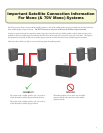
e exact configuration of a subwoofer/satellite loudspeaker system depends on a number of factors, such as:
• How large the room is and how many satellite speakers it will take to cover the room?
• Whether the distance between the satellite speakers allows a single subwoofer to cover the entire space?
• Whether the program material is light background music or dominant driving music?
• Where the subwoofer will be located in relation to room boundaries (wall, ceiling, corners)?
e system recommendations in this guide and the performance figures are based on some baseline assumptions which will not be
correct for all applications. Adjustments may need to be made. A discussion of the considerations, baseline assumptions conditions and
possible adjustment requirements is below.
Sub-Sat System Design
General Objectives
Sensitivity Balance
e volume balance between the subwoofer and the satellite
speakers in a passively crossed-over system is called sensitivity
balance.
Targets:
a) Sensitivity Balance – Typically, the way the human
hearing system works, the subwoofer needs to be 2 to 6
dB louder than the satellite speakers in order to sound
balanced. e subwoofer/satellite systems in this
guide are all structured to provide the proper range of
sensitivity balance with the subwoofer located on a flat
surface (wall, ceiling, floor). e sensitivity balance can
be altered, as required, via an active graphic equalizer.
e balance can also be altered by placing the subwoofer
closer to more boundary surfaces -- see the “Subwoofer
Location” section below for more about the effect of
positioning.
b) Maximum Sound Level Balance – It is desirable for
the subwoofer to be able to deliver adequate maximum
sound output capability to keep up with the satellite
speakers when they are driven at their maximum drive
level. e subwoofer output of these systems is high
enough to keep up with the satellite speakers at high
drive levels.
Subwoofer Model Selection
All the systems in this guide use the Control SB-210 subwoofer,
with the exception of the CCS6000 System, which uses the Control
SB-2 subwoofer. Passive crossover networks are built-into SB-2
and available for SB-210, making it easy to structure subwoofer-
satellite systems.
Designing for Other JBL Subwoofer Models
Other subwoofers from JBL Professional include Control 19CS
In-Ceiling Subwoofer and Control 312CS High Power In-Ceiling
Subwoofer. ese subwoofers are intended to be used in actively
crossed-over systems -- either contains a built-in passive crossover
network.
For determining the proper number of Control 19CS subwoofers,
use the Subwoofer Utility in the DSD Distributed System Design
software (free download located on the Software Download page
from the www.jblpro.com website).
For e Control 312CS subwoofer, use the “Control 300 Subwoofer
Ratio Guide” posted in the Control 300 section of the Technical
Library page on www.jblpro.com website.
4 5


















